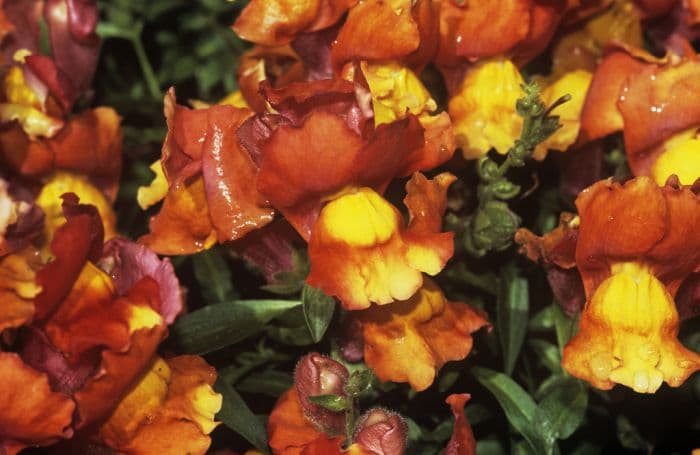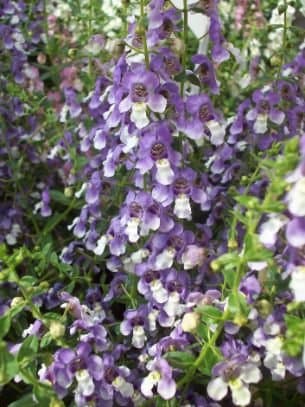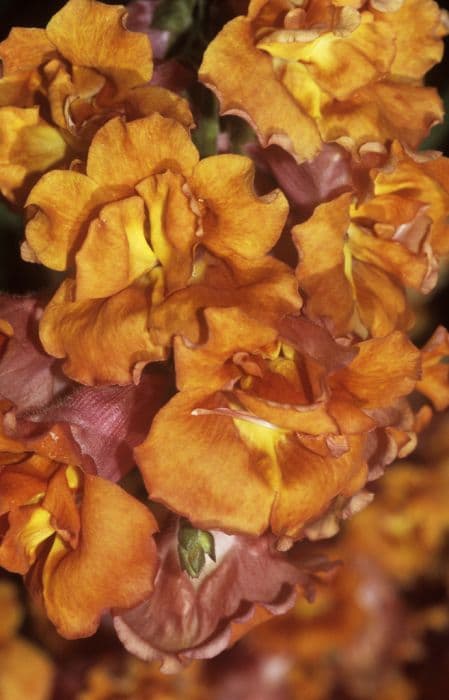Snapdragon Antirrhinum majus 'Floral Showers Deep Bronze' (Floral Showers Series)

ABOUT
Antirrhinum majus 'Floral Showers Deep Bronze'—commonly known as snapdragon—is a striking decorative plant renowned for its vibrant and unique flower colors. The 'Floral Showers' series, to which this plant belongs, is celebrated for its prolific blooming habit. The 'Deep Bronze' variety bears a captivating array of flowers, rich in deep bronze hues that blend elegantly with warm shades of orange and red, creating a sumptuous display of color. The snapdragon's blossoms are characterized by their distinctive snapdragon shape, with flowers that have a dragon's mouth appearance; these blooms are bilaterally symmetrical with upper and lower lobes. The flowers are tightly clustered along a spike, which creates vertical accents above the foliage. When pressed at the sides, the flower's "mouth" opens, which is a delight, especially for children who are often fascinated by this trait. The foliage of Antirrhinum majus 'Floral Showers Deep Bronze' consists of lance-shaped leaves that are medium green in color. These leaves form a lush backdrop for the flowers and together they create a rich tapestry of color and texture that draws the eye and adds depth to any planting arrangement. Although their size is not the focus, the overall form of snapdragon 'Floral Showers Deep Bronze' is compact and bushy, making it a popular choice for garden borders, beds, and containers where their stunning color can be displayed prominently. The beauty of this plant lies in its exquisite flowering spikes and the dramatic coloration that stands out in any garden setting, bringing an eye-catching array of bronze-toned blooms that capture interest throughout their blooming period.
About this plant
 Names
NamesSynonyms
Snapdragon, Dragon Flower
Common names
Antirrhinum majus
 Toxicity
ToxicityTo humans
The plant commonly known as Snapdragon is not known to be highly toxic to humans. However, if ingested in large quantities, it could potentially cause mild gastrointestinal irritation including nausea, vomiting, or diarrhea. It is always advisable to avoid eating ornamental plants and to keep them out of the reach of children who might ingest them out of curiosity.
To pets
Snapdragon is generally considered non-toxic to pets such as dogs and cats. While it is not common for pets to have a reaction to ingesting this plant, there is still a possibility of mild gastrointestinal upset, such as vomiting or diarrhea, if they consume large amounts of the plant. It is a good practice to monitor pets and discourage them from eating ornamental plants to avoid any potential issues.
 Characteristics
CharacteristicsLife cycle
Annuals
Foliage type
Deciduous
Color of leaves
Green
Flower color
Bronze
Height
8 inches (20 cm)
Spread
10 inches (25 cm)
Plant type
Herb
Hardiness zones
9
Native area
Mediterranean
Benefits
 General Benefits
General Benefits- Aesthetic Appeal - Adds vibrant color and visual interest to gardens with its deep bronze-hued flowers.
- Easy to Grow - Known for being low-maintenance and easy to cultivate, ideal for both novice and experienced gardeners.
- Extended Blooming - Features a long flowering season, producing blooms from spring to fall.
- Attracts Pollinators - Flowers attract bees, butterflies, and other pollinators, contributing to the health of your garden ecosystem.
- Versatility - Suitable for planting in garden beds, borders, and containers, offering flexibility in garden design.
- Drought Tolerance - Once established, it can tolerate brief periods of drought, requiring less frequent watering.
- Compact Growth - With its dwarf habit, it's well-suited for small spaces or as a ground cover.
- Cold Hardy - Resilient against cooler temperatures, making it a good choice for gardens in various climates.
 Medical Properties
Medical PropertiesThis plant is not used for medical purposes.
 Air-purifying Qualities
Air-purifying QualitiesThis plant is not specifically known for air purifying qualities.
 Other Uses
Other Uses- Photography Prop: Snapdragons, with their vivid colors and unique dragon-like shaped blooms, are often used by photographers as a vibrant subject or as a natural backdrop for portrait photography.
- Educational Model: Biology teachers may use snapdragons to demonstrate the concept of incomplete dominance in genetics, as their crossbreeding can result in a blend of parent flower colors.
- Children’s Crafts: Due to their interesting shape and ease of manipulation, snapdragon blooms can be used in children’s art projects, such as creating flower dolls or whimsical garden scenes.
- Drying for Scrapbooking: Snapdragon flowers can be dried and pressed to use in scrapbooking or card making to add a three-dimensional and natural element to crafts.
- Mood Boards and Vision Boards: For individuals compiling imagery to represent their goals and dreams, snapdragons can be placed on vision boards to signify grace, strength, or transformation.
- Plant Dye: The bright petals can be used to create natural dyes for fabrics or handmade paper, giving items a unique and organic hue.
- Culinary Garnish: Although not commonly consumed, the petals of some snapdragon varieties can be used to decorate salads and desserts, adding an unexpected splash of color.
- Fairy Gardens: Miniature snapdragons can be incorporated into fairy gardens for enchanting landscape design, complementing the whimsical theme with their delicate flowers.
- Table Centerpieces: The erect flower spikes and rich colors can make simple yet elegant table centerpieces for events, adding height and drama to table settings.
- Garden Puzzles and Games: The distinctive flowers can be utilized in garden-based puzzles or memory games for children, encouraging them to match shapes or colors.
Interesting Facts
 Feng Shui
Feng ShuiThe Snapdragon is not used in Feng Shui practice.
 Zodiac Sign Compitability
Zodiac Sign CompitabilityThe Snapdragon is not used in astrology practice.
 Plant Symbolism
Plant Symbolism- Deception: Also known as the "Snapdragon," Antirrhinum majus symbolizes deception because of its flower's resemblance to a dragon's mouth that opens and closes when gently squeezed.
- Graciousness: The Snapdragon also conveys graciousness and benevolence, possibly due to the varied and beautiful colorations.
- Strength: As a resilient plant that can grow in rocky areas, Snapdragons represent strength and the ability to overcome life's challenges.
- Protection: In some folklore, Snapdragons were thought to offer protection from deceit, curses, and theft when planted in gardens.
 Water
WaterSnapdragons should be watered regularly to maintain moist but not waterlogged soil. During the growing season, watering should occur once or twice a week, depending on weather conditions. Apply about 1 inch of water each time, which translates to approximately 0.6 gallons per square foot every week. It's best to water the plant at the soil level to avoid wetting the foliage, as wet leaves can lead to fungal diseases. During hot, dry spells, you might need to water more frequently to prevent the soil from drying out completely.
 Light
LightSnapdragons thrive in full sun to partial shade. They perform best with at least 6 hours of direct sunlight each day, though they can tolerate some light afternoon shade, especially in hot climates. A spot that provides morning sunlight and some protection from the intense heat of late afternoon is ideal for these plants.
 Temperature
TemperatureSnapdragons prefer cooler temperatures and will thrive when daytime temperatures are around 70°F and nights are between 40 and 50°F. They can survive short periods when temperatures dip just below freezing, but prolonged exposure to temperatures below 40°F or above 85°F can be detrimental to the plant. To encourage flowering and healthy growth, maintaining temperatures within this range is ideal.
 Pruning
PruningSnapdragons benefit from occasional pruning to encourage bushier growth and more flowers. Pinch back the tips of young plants to stimulate branching, and deadhead spent flowers regularly to promote continuous blooming. In areas with mild winters, cutting back the plants in late fall can encourage a second flush of growth in early spring. Pruning is typically needed every few weeks during the growing season to maintain shape and vigor.
 Cleaning
CleaningAs needed
 Soil
SoilSnapdragons such as 'Floral Showers Deep Bronze' thrive in a well-draining soil mix composed of equal parts peat, loam, and sand or perlite. Aim for a soil pH between 6.2 and 7.0 for optimal growth and flowering.
 Repotting
RepottingSnapdragons generally do not require frequent repotting, but if grown in containers, repotting every 1-2 years is beneficial. Ensure to refresh the soil during repotting to provide new nutrients.
 Humidity & Misting
Humidity & MistingSnapdragon 'Floral Showers Deep Bronze' tolerates a wide range of humidity levels, but it does best in moderate conditions. Aim for a humidity level around 40-50% for optimal health and flowering.
 Suitable locations
Suitable locationsIndoor
Place in sunny spot, ensure good airflow, use well-draining soil.
Outdoor
Plant in full sun, well-drained soil, after frost danger.
Hardiness zone
7-11 USDA
 Life cycle
Life cycleAntirrhinum majus 'Floral Showers Deep Bronze', commonly known as Snapdragon, begins its life as a seed, typically sown in early spring under cover or directly outdoors after the last frost. Upon germination, the seedling emerges and develops its first set of true leaves, entering the vegetative growth stage where it focuses on root and foliage development. As temperatures warm, the Snapdragon transitions to the flowering stage, producing tall spikes adorned with deep bronze-colored blossoms that are attractive to pollinators. After pollination, the flowers fade and the plant forms seed pods, completing its reproductive stage. If conditions allow, the Snapdragon may enter a dormancy period, particularly in regions with mild winters, and can re-emerge for a subsequent growing season. Ultimately, the lifecycle culminates with the parent plant's senescence and death, leaving behind seeds to continue the species' existence.
 Propogation
PropogationPropogation time
Spring-early summer
Propogation: The most common method of propagating Snapdragon 'Floral Showers Deep Bronze' is by sowing seeds. Ideally, seeds should be started indoors about 6 to 8 weeks before the last expected frost. Spread the tiny seeds on the surface of a well-draining seed starting mix, as they need light to germinate, and do not cover them with soil. Keep the soil evenly moist and at a temperature of about 65 to 70 degrees Fahrenheit (18 to 21 degrees Celsius). Germination usually occurs within 10 to 21 days. Once seedlings have developed a few true leaves, they can be transplanted to individual pots and later moved to their final location outdoors after the danger of frost has passed.









